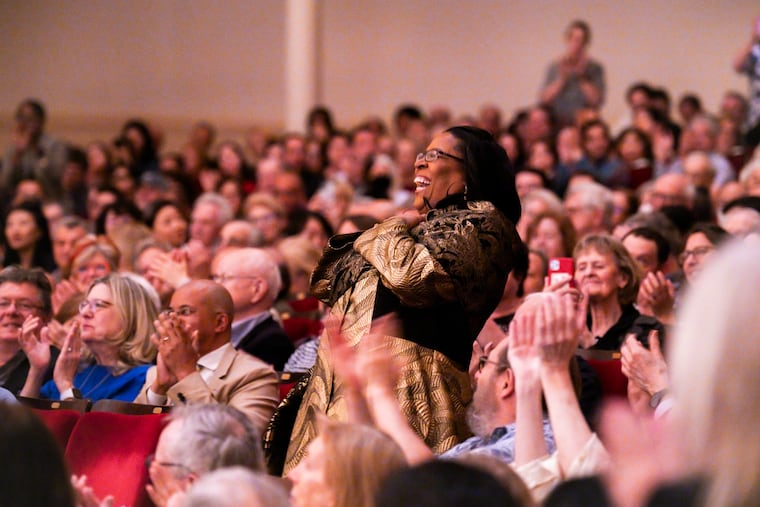Philadelphia Orchestra premieres new Valerie Coleman ‘Concerto for Orchestra’ to rave reviews
Coleman chose not to face her newfound admirers with a bow from the Carnegie Hall stage, but waved from her aisle seat on the main floor.

NEW YORK — Though heard at Carnegie Hall as long ago as 2004, composer-flutist Valerie Coleman was received like a major new discovery on Friday when the Philadelphia Orchestra unveiled her new Concerto for Orchestra (“Renaissance”) in a Debussy/Ravel program (featuring much-honored pianist Mitsuko Uchida) that received a rock star audience welcome.
The piece was premiered Thursday in Philadelphia (to be repeated Saturday and Sunday at the Kimmel Center). Coleman is part of the city’s Imani Winds chamber-music group and the author of three previous works written for the Philadelphia Orchestra, including Seven O’Clock Shout — a COVID-era, trauma-transcending piece establishing her as a composer using the congenial Aaron Copland/Samuel Barber tradition as a launching point for her own distinctive voice.
Oddly, on Friday, Coleman chose not to face her newfound admirers with a bow from the Carnegie stage, but waved from her aisle seat on the main floor. She later said that it would just take too much time to go up and back. Besides, listeners went out of their way afterward to address her directly and emphatically at her seat. Commonly heard: “You are a great composer!”
The title, Concerto for Orchestra (“Renaissance”), carries double meaning, referring to Bartok’s landmark Concerto for Orchestra, as well as the Harlem Renaissance of the 1920s and ‘30s that previously prompted Coleman to write smaller-scale musical portraits of poet Langston Hughes and cabaret star Josephine Baker. The new piece is her largest (“so far,” she said after the premiere), and one showing how she has made quantum leaps with an often-spectacular orchestration that she attributes to the guidance of music director Yannick Nézet-Séguin.
Her pieces are full of extra-musical references — this one’s three movements are subtitled “American Odyssey,” “Portraits,” and “Cotton Club Juba” — but aren’t dependent on reading program notes to create a vivid listening experience. That said, Coleman cites specific passages in the new work that refer to paintings of African American artist Jacob Lawrence (1917-2000) that document the northward migration amid Jim Crow laws with vivid colors and folk-art directness, as well as depicting World War II more abstractly with diagonal perspectives, bodies mashed together, and an overall sense of danger.
As with the Lawrence paintings, each section of Coleman’s music had its own distinctly crafted color palette, but within that, eloquent, disparate layers of meaning that also give most sections of the orchestra antic animation solo moments with the kind of unfiltered truth that one doesn’t expect in the symphonic medium. The first movement was full of bustling, contrasting personalities, but what developed in the amassed string section was broad, tectonic motion suggesting important shifts in the society being depicted.
The second two movements ran together in what wasn’t anything so tidy as an orchestral tone poem, but a landscape full of ever-evolving discoveries. If the brass were playing fanfares, they weren’t typical, twisting around with anything-but-predictable jazz-influenced motion — and with the subtle defiance of an alternate sensibility.
The final Cotton Club section could’ve inspired conventionally showy symphonic jazz but was dense and eventful, dipping into dark back rooms, full of hectic and at times heedless activity. Arresting, slashing orchestral gestures could be heard any number of ways, whether liberating or debilitating.
Yet these large Coleman canvases maintained a chamber music feeling in sound, drawing their overall power from details within details. The consistent vitality made the music endlessly engaging — attracting the ear not by being imposing or commanding, but by being inviting. This piece may take listeners years to fully digest, but never do you feel that the music is leaving you behind.
The piece was played by the Philadelphia Orchestra with great conviction — and conducted by Nézet-Séguin with obvious relish. But what followed was a fasten-your-seat-belt performance of Debussy’s “La Mer.”
While many conductors have this French impressionist composer treading in soft-sole shoes, this performance put him in spike heels, sounding like a companion piece to Stravinsky’s fierce “Rite of Spring.” Years of hearing “La Mer” and its elemental depiction of the sea never suggested that it could be played this way.
Agree or not with this approach, the performance was consistently and convincingly conceived and viscerally compelling. It was also loud — which is an increasingly heard complaint of Nézet-Séguin’s performances among New York audiences.
Pianist Uchida left a strangely mixed impression in Ravel’s “Piano Concerto in G.” One associates her more with Beethoven and Schubert, and the fidelity to the written score demanded by those composers was much in evidence as she played Ravel.
But there’s much more to that piece than what’s on the page. Her rhythm lacked flexibility. The first two movements almost seemed prosaic. The final movement kicked in with Uchida giving Ravel’s keyboard runs Mozartean precision and elegance. But in general, she seemed to be keeping up with the concerto rather than leading it.
This is clearly a minority opinion — the audience loved it — though it’s good to know that this great musician is indeed human, and not one to please everybody all the time.
The program will be repeated at 8 p.m. Saturday and 2 p.m. Sunday at the Kimmel Center. Tickets: $25-181. Information: 215.893.1999 or https://www.ensembleartsphilly.org/